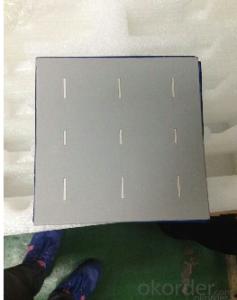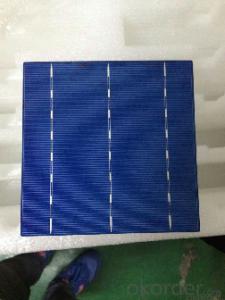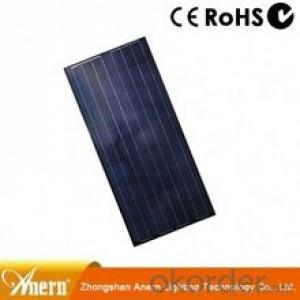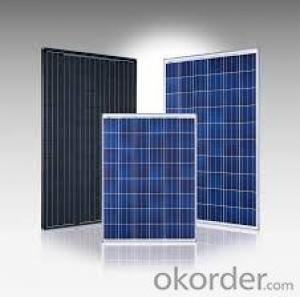Poly Solar 156mmx156mm Cells from CNBM Solar
- Loading Port:
- China main port
- Payment Terms:
- TT OR LC
- Min Order Qty:
- 500 pc
- Supply Capability:
- 10000000 pc/month
OKorder Service Pledge
OKorder Financial Service
You Might Also Like
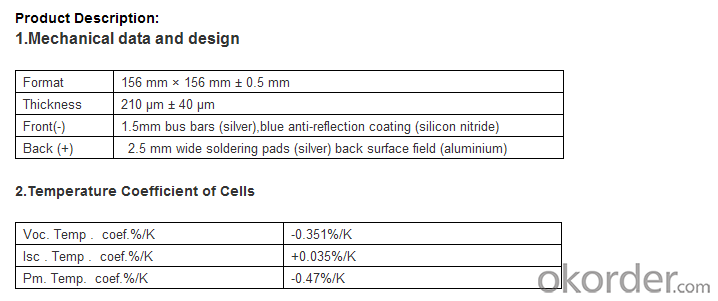

4.Specifications
1. High conversionefficiency
2.Superior quality
3.Lowest price
4.Certificate:CE,ROHS,IEC,TUV,UL.
5. Prompt delivery
5.Feature:
High conversion efficiencies resulting in superior power outputperformance
Outstanding power ourput even in low light or high temperatureconditions
Optimized design for ease of soldering and lamination
Long-term stability,reliability and performance
Low breakage rate
Color uniformity
6.Quality Assurance & Control
ISO9001 quality management system and ISO14001 environmentalmanagement system standard are completely implemented in our company's solarcell manufacture process.
1, classified efficiency grades by both minimum power and powercurrent
2, Screened for reverse current and shunt resistance
3, Constant reliability monitoring
4, Sorted into four defined color classes
5, Minimal button marks
6, No beading
7,Low warpage and bowing
8, REACH-SVHC and RoHS compliant
7.Images

8.FAQ
What's your advantages?
1. High efficiency and High power.
2. Long-term electrical stability.
3. Lowest price and Fastest delivery.
4. Good quality and good service.
5. Bulk supply
6. Good Warranty
7. Big Sale
8. More than 25 years on the lifetime.
- Q:Can solar cells be used for powering water pumps?
- Yes, solar cells can be used for powering water pumps. Solar-powered water pumping systems utilize photovoltaic cells to convert sunlight into electricity, which can then be used to power water pumps. These systems are environmentally friendly, cost-effective, and reliable, making them a popular choice for remote areas or locations where grid electricity is not available.
- Q:Can solar cells be used in desalination plants?
- Yes, solar cells can be used in desalination plants. Solar energy can be harnessed to power the desalination process, either directly or indirectly. Direct methods involve using solar panels to generate electricity to power the desalination process, while indirect methods involve using solar thermal energy to heat the water and drive the desalination process. Both methods have been successfully implemented in various desalination plants around the world, offering a sustainable and environmentally-friendly solution to produce fresh water.
- Q:How can I explain to my 10 year old daughter what solar cells are?
- According to Wikipedia: A solar cell, or photovoltaic cell (in very early days also termed "solar battery"[1] – a denotation which nowadays has a totally different meaning, see here), is an electrical device that converts the energy of light directly into electricity by the photovoltaic effect, which is a physical and chemical phenomenon.
- Q:How are solar cells made?
- Solar cells are typically made using a process called photovoltaic manufacturing, which involves several steps. First, silicon, which is the main material used in solar cells, is extracted from silica, a component of sand. The extracted silicon is then purified and transformed into a crystal structure suitable for solar cell production. These silicon wafers are then cut into thin slices. Next, various layers of conductive materials and anti-reflective coatings are applied to the wafer, creating the necessary electrical properties and enhancing light absorption. Finally, electrical contacts are added to the cell, allowing the generated electricity to be collected and used.
- Q:What is the environmental impact of solar cells?
- Solar cells have a relatively low environmental impact compared to other forms of energy generation. While their production does require the extraction and processing of raw materials, such as silicon and metals, the overall energy and resource requirements are relatively low. Furthermore, solar cells generate electricity without emitting greenhouse gases or other pollutants during operation, reducing air and water pollution. Although their end-of-life disposal can pose some environmental challenges, proper recycling and waste management can minimize these impacts. Overall, the environmental benefits of solar cells, including reduced carbon emissions and resource conservation, outweigh their limited environmental footprint.
- Q:Can solar cells be used for powering remote weather monitoring stations?
- Yes, solar cells can be used for powering remote weather monitoring stations. Solar cells, also known as photovoltaic cells, convert sunlight into electricity, which can be used to power various devices and systems. Remote weather monitoring stations often require a consistent and reliable source of power, especially in locations where access to the electrical grid is limited or non-existent. Solar cells provide a sustainable and environmentally-friendly solution for these stations by harnessing sunlight to generate electricity, ensuring continuous operation of the monitoring equipment.
- Q:What is the best way to deal with surplus solar cells abandoned after burning?
- It could be a very good resource to be used, but the technology needs to be more advanced to really deal with that.
- Q:What is the maximum efficiency achievable by a solar cell?
- The maximum efficiency achievable by a solar cell is determined by the Shockley-Queisser limit, which states that the theoretical maximum efficiency is around 33.7% for a single-junction solar cell. However, in reality, due to factors such as material limitations and losses in the conversion process, the practical maximum efficiency of commercial solar cells currently ranges between 15% to 22%.
- Q:What is the impact of tree shading on solar cell performance?
- Tree shading has a significant negative impact on solar cell performance as it reduces the amount of sunlight reaching the cells, thereby reducing the overall energy output. Shading blocks direct sunlight and creates uneven distribution of light, resulting in decreased efficiency and potentially even causing parts of the cells to operate in reverse, leading to further energy loss. It is crucial to plan solar installations carefully, considering tree growth and shading patterns, to maximize solar cell performance.
- Q:Can solar cells be used for powering remote oil and gas pipelines?
- Yes, solar cells can be used for powering remote oil and gas pipelines. Solar energy is a sustainable and reliable source of power that can be harnessed in remote locations. By installing solar panels along the pipeline, energy can be generated and used to operate various equipment and systems, reducing the reliance on traditional power sources and minimizing the environmental impact.
1. Manufacturer Overview |
|
|---|---|
| Location | |
| Year Established | |
| Annual Output Value | |
| Main Markets | |
| Company Certifications | |
2. Manufacturer Certificates |
|
|---|---|
| a) Certification Name | |
| Range | |
| Reference | |
| Validity Period | |
3. Manufacturer Capability |
|
|---|---|
| a)Trade Capacity | |
| Nearest Port | |
| Export Percentage | |
| No.of Employees in Trade Department | |
| Language Spoken: | |
| b)Factory Information | |
| Factory Size: | |
| No. of Production Lines | |
| Contract Manufacturing | |
| Product Price Range | |
Send your message to us
Poly Solar 156mmx156mm Cells from CNBM Solar
- Loading Port:
- China main port
- Payment Terms:
- TT OR LC
- Min Order Qty:
- 500 pc
- Supply Capability:
- 10000000 pc/month
OKorder Service Pledge
OKorder Financial Service
Similar products
New products
Hot products
Hot Searches
Related keywords

